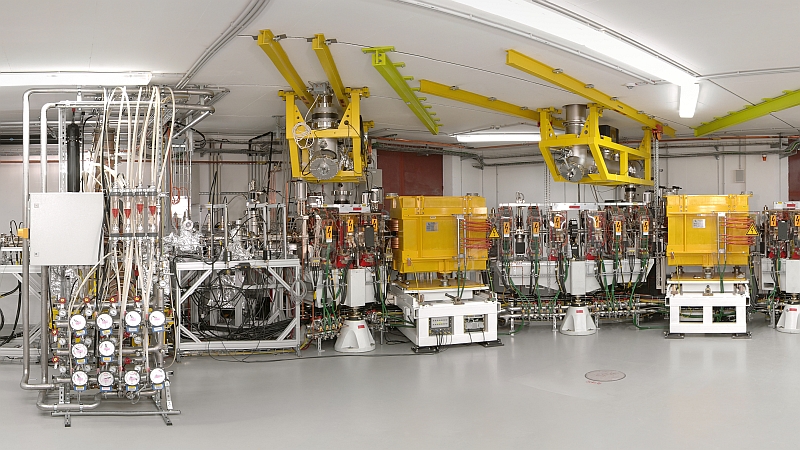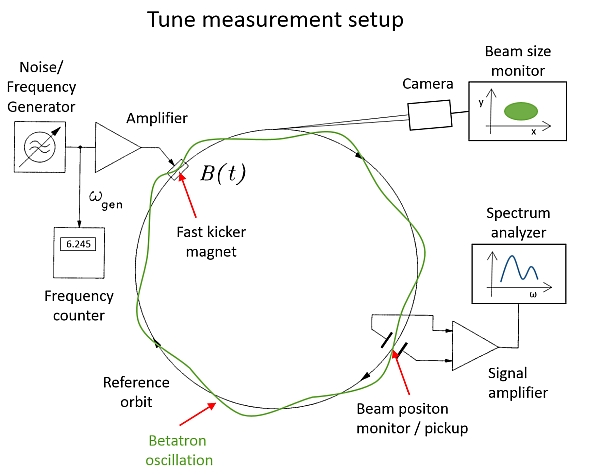Department High Brightness Beams
WS2019/2020: Fortgeschrittenenpraktikum HU Berlin Physik - Versuch/Experiment ''Betatron Tune Knob''
What you will learn
The goal of the experiment is to derive a method to control the horizontal and vertical betatron tunes of the Metrology Light Source (MLS) storage ring (betatron tune knob). You will learn basic topics related to the motion of electrons in a storage ring and linear electron beam optics. You will also get in touch with devices to excite and detect coherent oscillations and beam orbit motion. You will also see synchrotron radiation.
All this will be done at the MLS, a multi-million EUR particle accelerator, located on campus in Adlershof.

Photo of the PTB Metrology Light Source operated by HZB in Berlin-Adlershof
What you should know
You should be familiar with basic linear electron beam optics and tune measurement and manipulation techniques. You will need a table with MLS parameters during the experiment. Download, read and understand the lab manual and the material provided with it.

MLS Tune Measurement Setup
What to bring with you
Bring a laptop computer or a pocket calculator to compute some parameters during the experiment. It could be useful to implement scripts for the analysis in python or Matlab. With that you can quickly check for any inconsistencies in the data or missing information.
If you have an Android smartphone you can download TAPAs, the Toolkit for Accelerators on Androids. The app allows back-of-the-envelope kind calculations for typical accelerator physics problems.
Motivation
What is the tune? A string instrument like an acoustic guitar needs to be tuned from time to time. A guitar may become out of tune, meaning that the tone the guitar is producing is either too high or too low in relation to a chosen reference pitch. This happens with ambient temperature, humidity and other effects. Tuning means here the the process of adjusting the pitch of one or many tones from the guitar to establish typical intervals between these tones.
In a electron storage ring like the MLS the tune is the number of betatron oscillations per revolution. Since the betatron motion is mainly determined by the electron optics the tune is a property of the machine rather than the beam. The exact value of the tune is of great importance in storage rings, where the beam is kept recirculating for many hours while being subjected to all kinds of linear and non-linear forces. At times, small variations of the tune by a few 0.0001 of an integer decide about the well being of the beam. The goal of this project is to characterize the tune and the betatron oscillation in the storage ring and build a tool to tune the accelerator in a determined manner to a chosen reference value, like you would tune your guitar.
Practical things
We can offer the experiment only at selected weekends. Possible dates in the summer term SS 2020 are:
No. Date Time Availability
1 Sat 13.06.2020 15:00 to 19:00 open
2 Sun 14.06.2020 09:00 to 13:00 open
3 Sun 14.06.2020 14:00 to 18:00 open
4 Sat 20.06.2020 15:00 to 19:00 open
5 Sun 21.06.2020 09:00 to 13:00 open
6 Sun 21.06.2020 14:00 to 18:00 open
Before you can do the experiment, you need to take part in a pre-examination. Furthermore all groups will be able to visit the MLS before doing the experiment. The dates for the pre-exams and MLS visit are:
Pre exam (Vortestat) for 1, 2, 3 Thu 11.06.2020 10:00 to 13:00
Pre exam (Vortestat) for 4, 5, 6 Thu 18.06.2020 10:00 to 13:00
All visit MLS (tba)
Please contact Thorsten Kamps for more details and availability of dates.
